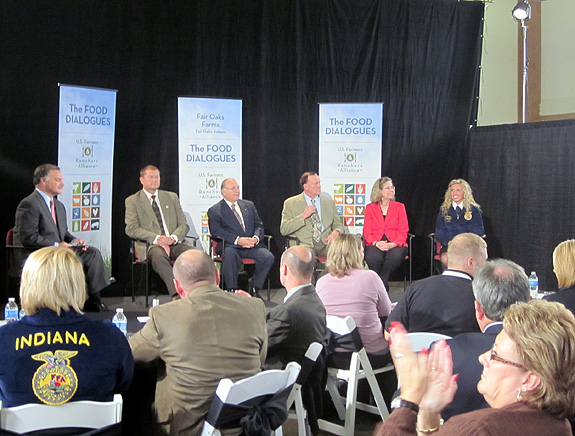The Food Dialogues Thursday took place in four U.S. locations and online for over five hours (11:30 a.m. to 5 p.m. EDT). In addition to the Fair Oaks dairy farm in Indiana, the other locations were The Newseum in Washington, D.C., Chelsea Studios in New York City, and the Robert Mondavi Institute at the University of California, Davis. All four locations were connected live via satellite and streamed on the Internet on Facebook and on www.fooddialogues.com
 The discussions addressed Americans' questions about how their food is grown and raised and the long-term impact of the food they are eating - on their health and the health of the planet. The event included four panel discussions featuring leaders in food, food service, media and policy, farmers of all types and business leaders who all shared different viewpoints about the current and future state of food.
The discussions addressed Americans' questions about how their food is grown and raised and the long-term impact of the food they are eating - on their health and the health of the planet. The event included four panel discussions featuring leaders in food, food service, media and policy, farmers of all types and business leaders who all shared different viewpoints about the current and future state of food.
The panel discussion from Fair Oaks focused on "The Voice of Farmers and Ranchers." The moderator was Max Armstrong of Farm Progress Companies. The panelists were Malcolm DeKryger, vice president of Belstra Milling Co.; Phil Bradshaw, Illinois soybean, corn and hog producers, former vice chairman of the United Soybean Board and vice chairman of USFRA; Mike McCloskey, president and co-founder of Fair Oaks Farms; Wendy Wintersteen, dean of the College of Agriculture at Iowa State University; and Casie Conley, state president of the Indiana FFA Organization.
The Food Dialogues event opened at the Indiana site. In the early discussion at Fair Oaks, the panelists conceded that historically farmers have not been very interactive with consumers, noting that only a few generations ago it was not necessary when most everyone had a grandparent or uncle still on the farm. They also voiced their dismay about the perception that "big farming" is bad and explained that most corporate farms remain family farms.
One of the first points made was that consumers "expect consistency" when sitting down to a meal, especially consistency in quality and safety of the food.
That prompted Bradshaw to comment on the issue of how best to raise hogs. "When raising hogs outside we had to deal with the issues of heat and cold - and predators," he said. For most commercial pork producers raising the hogs in indoor facilities has proven to be better for the animal and providing the consistency of product consumers expect.
Bradshaw added that he and many other hog producers do not use hormones, and antibiotics only when necessary. "We read that consumers are not comfortable with hormones, so we don't use them, although I don't know that I agree (with the concerns).
DeKryger pointed out the medicines are expensive, so producers always want to be judicious in their use. "The profit margin is narrow," he said. It was also noted that the use of hormones and antibiotics is regulated and overseen by veterinarians.
McCloskey added that farmers "enjoy our animals and take care of them" and that it is a "privilege to be a part of the safe food chain."
Moving on to the topic of technology, Armstrong observed how agriculture technology today is extensively studied. Wintersteen wholeheartedly agreed, saying science and technology is used everywhere in our lives, and this is no less true in agriculture.
Speaking on behalf of her generation, Conley asked "what better group to put in charge of technology" than those in their 20s who are most adept at using it. She was enthusiastic about the opportunities for college students studying in agriculture fields.
Wintersteen agreed, saying she was "excited" about the students in their program, and adding they need more. The others also agreed. DeKryger said "our nation is in great shape" with agriculture students and the university programs available to them.
McCloskey said "we're bullish about the future of agriculture in the U.S. Are there challenges? Sure. But that keeps us on top of our game."
The panelists at Fair Oaks concluded their portion of the event by accepting questions from the local audience, from the other sites and from the Internet. Topics ranged from the agriculture carbon footprint, to genetically-modified products (GMOs), and to testing of agriculture products beyond the farm.
The topics at the other locations were:
- "The View from 30,000 Feet" (Washington, D.C.), Moderator Phil Lempert, food trends analyst and editor, The Lempert Report/supermarket Guru; Guest speaker Tom Vilsack, secretary, U.S. Department of Agriculture; Emcee Claire Shipman, ABC News.
- "The Future of Agriculture" (Davis, Calif.), Mderator Jane Wells, CNBC.
- "From Farms and Ranches to Menus and Check-out Counters" (New York City), Moderator Chef John Besh.
Survey findings released during the Food Dialogues indicate Americans constantly think about food production, yet have little connection to farming or ranching; also respondents split on whether agriculture is improving or heading in wrong direction.
“Americans have a lot of questions about where their food comes from, how it is raised and if it is good for their health long-term,” said Bob Stallman, chairman of USFRA and president of the American Farm Bureau Federation.
“USFRA commissioned two separate surveys to first ask farmers and ranchers what they wished Americans could have more information about where their food comes from. We then asked consumers what questions they have on the same topic. The findings of both surveys indicate there is an opportunity for more dialogue between farmers, ranchers and the American public about how food is grown and raised in the U.S.”
Highlights of the research include:
- While nearly all Americans agree that food production is important to the success of the country, they are split over whether it is going in the right or wrong direction.
- Consumers think about food production constantly, yet know very little about how food is brought to the dinner table.
- Overwhelmingly, farmers and ranchers share the same values as consumers on issues related to environmental stewardship and animal care.
Additional Consumer Survey Highlights
The purpose of the consumer survey was to ask Americans what additional information they want to learn more about related to how food is grown and raised in the U.S. The survey revealed that consumers have become disconnected from their food, yet think about the subject regularly. According to the survey findings:
- 72 percent of consumers know nothing or very little about farming or ranching.
- 69 percent of consumers think about food production at least somewhat often.
- 70 percent say purchase decisions are affected by how food is grown and raised, with three-quarters (72 percent) of Americans saying they think about this topic while purchasing groceries.
- 42 percent or two-in-five Americans say the way that food is grown and raised has improved in the last 10 years, while a slightly smaller group say it has worsened (37 percent).
- Those who say the way that food is grown and raised has improved cite food safety (22 percent) and food quality (17 percent), whereas respondents who said the way food is grown and raised has worsened also cite food safety (21 percent) and food quality (21 percent).
- Of all the aspects of how food is grown and raised, Americans are most satisfied with the availability of healthy foods (73 percent) and food safety standards (66 percent).
- One in five consumers who say food production has worsened in the last 10 years cite environmental impact as the top area of demise.
- 79 percent of consumers say producing healthy choices for all consumers is very important for farmers and ranchers to consider when planning farming and ranching practices.
Consumers also were asked to identify the top five topics they want more information about; responses included:
- How chemicals are used in farming/ranching.
- How pesticides are used in farming/ranching.
- Food safety standards.
- Effect of government regulations on farming/ranching.
- How antibiotics are used and genetic engineering in crops.
Additional Farmer/Rancher Survey Highlights
The goal of the farmer/rancher survey was to identify topics that farmers and ranchers wished Americans had more information about when it comes to food and how it is grown and raised in the U.S. According to the survey, farmers and ranchers said the top misconception they need to overcome as an industry is that a few “bad actors” are representative of the entire industry. Additionally, farmers and ranchers identified the effect of pesticides, antibiotics and fertilizers on food as the most important priorities they should address when communicating with consumers. Additional findings included:
- 86 percent of farmers/ranchers responded that the average consumer has little to no knowledge about modern farming/ranching.
- 58 percent of respondents in this survey felt consumers have a completely inaccurate perception of farming and ranching.
- Nearly all farmers and ranchers say that protecting the environment (99 percent) and practicing humane animal care (96 percent) are very or somewhat important goals or practices related to their business.
- 80 percent of farmers/ranchers say that consumers have little to no knowledge about proper care of livestock or poultry.
- 83 percent of farmers/ranchers responded that new ways of improving yields with fewer environmental inputs will have a major impact on farming/ranching in the future.
When asked which top five topics were most important to educate consumers about, farmers and ranchers responded:
- The effect of pesticides, fertilizers and antibiotics on food.
- Where food comes from in general.
- Proper care of livestock and poultry.
- Effect of government regulations on farming/ranching.
- Economic value of agriculture.
“We hope the results of the survey combined with today’s Food Dialogues event will continue the conversation between farmers, ranchers and anyone who is interested in learning more about how food is grown and raised in the U.S.,” added Stallman. “We want all Americans to join us to ask questions and regularly get information from farmers and ranchers who are growing and raising their food. We invite all to join the discussion online at www.fooddialogues.com.”
For additional information on the surveys or The Food Dialogues event, visit www.fooddialogues.com.
About the Surveys
The 2011 USFRA Farmer/Rancher Survey was fielded by phone for USFRA by Ketchum Global Research Network and Braun Research between August 6-18, 2011, reaching 1,002 farmers and ranchers nationwide. The base sample has a margin of error of +/- 3.1 percent.
The 2011 USFRA Consumer Survey was fielded by phone for USFRA by Ketchum Global Research Network and Braun Research between August 24-31, 2011, reaching 2,417 consumers nationwide. The base sample has a margin of error of +/- 2.0 percent.
About U.S. Farmers & Ranchers AllianceSM
U.S. Farmers & Ranchers Alliance (USFRA), established in 2010 and headquartered in Chesterfield, Mo., currently represents more than 50 of the top farmer- and rancher-led organizations and agricultural partners. The Alliance includes prominent agricultural groups at the national, regional and state levels that have collaborated to lead the dialogue about their commitment to continuous improvement and best production practices.
For more information on the Alliance, affiliates and partners and the movement to lead the conversation with Americans about today’s agriculture, visit www.fooddialogues.com; http://www.facebook.com/pages/US-Farmers-Ranchers-Alliance/103189669746931 and http://twitter.com/USFRA.
Press releases from USFRA contributed to this article.
The USFRA press releases were wholly or partially funded by one or more Checkoff programs.







